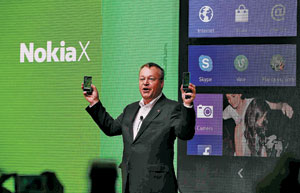Smartphone wars shift from gadgetry to price
(Agencies) Updated: 2014-02-27 09:49Nokia X
This shifting landscape has already forced Nokia, the former mobile world-beater now struggling to stay relevant, to adopt Google's Android software to gain entry to the low-end smartphone market, despite Android being an arch rival of Nokia's new-owner-to-be Microsoft.
|
 |
|
 Xiaomi to launch online sale of high-end Mi3 phone in Taiwan |
Wood said Nokia's move spoke volumes about the pressures the whole industry was feeling.
"The cheaper end of the smartphone market has become such a big opportunity that, eventually, Nokia had to go to a rival software system -- Google's Android," he said, describing the move as "hugely controversial, but necessary".
The cheap stripped-down smartphones, which often sacrifice big screens, memory, and camera quality and have fewer novelty features such as fingerprint recognition, are designed to reach potentially billions of new consumers in emerging markets.
Smartphone sales last year overtook for the first time sales of so-called basic 'feature' phones, which focus on just calls and texts with a pared down Internet access, according to market tracking firm Strategy Analytics.
And IDC analyst Francisco Jeronimo said smartphone sales in the sub-$100 category alone more than tripled to hit 159 million last year from 45.4 million in 2012. Sub-$50 smartphones grew even faster, up from just 900,000 in 2012 to 19.5 million last year.
|
 |
 |
- NHTSA says finds no 'defect trend' in Tesla Model S sedans
- WTO rare earth ruling is unfair
- Amway says 2014 China sales may grow 8%
- President Xi in Europe: Forging deals, boosting business
- CNOOC releases 2013 sustainability report
- Local production by Chery Jaguar Land Rover this year
- Car lovers test their need for speed in BMW Mission 3
- China stocks close mixed Monday

















